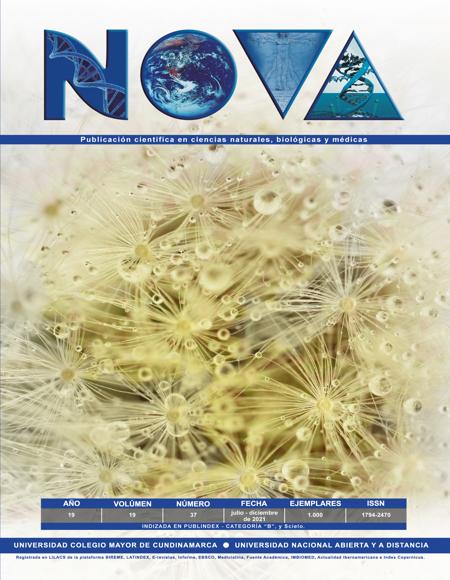Producción de astaxantina bajo factores de estrés utilizando un biorreactor a escala de laboratorio de 5 L
Astaxanthin production under stress factors using a 5L laboratory scale bioreactor
Mostrar biografía de los autores
Introducción. Haematococcus pluvialis es una microalga que produce astaxantina, un betacaroteno y antioxidante muy usado en la industria. Para obtener una mayor producción de astaxantina se planteó como Objetivo utilizar diferentes factores de estrés, en un biorreactor a escala de laboratorio de 5 litros. Metodología. Se cultivó la microalga en el medio RM, pH 6,8, temperatura 20±2ºC, aire filtrado, iluminación con lámparas blancas 20h luz/4h oscuridad, irradianza 70 μE m−2s−1, diferentes concentraciones de acetato de sodio y cloruro de sodio. Se determinó crecimiento celular, cambios morfológicos y cuantificación de astaxantina y clorofila por espectrofotometría. Se realizó un análisis estadístico utilizando ANOVA (95%).
Resultados. Utilizando 0,299 mg/L de acetato de sodio se obtuvo un crecimiento celular de 2,0 x 104 Cel/mL y una concentración de astaxantina de 2,530 µg/mL, mientras que con 1,6 mg/L de acetato de sodio el crecimiento celular fue de 3,5 x 104 Cel/mL y una concentración de astaxantina de 1,9 µg/ml. El tratamiento al cual se le adicionó 1,6 g/L de acetato de sodio y 6,4 g/L de cloruro de sodio presentó la mayor producción astaxantina 7,3 µg/ml. El tratamiento con acetato de sodio 0,320 g/L + cloruro de sodio 1,28 g/L presentó el mayor crecimiento celular con 1,64x105 células/ml. Conclusión. Esta investigación destaca la importancia de cultivar inicialmente la microalga utilizando el biorreactor Tecferm de 5 litros y después de su fase exponencial someterla a factores de estrés con acetato de sodio y cloruro de sodio lográndose así la mayor producción de astaxantina 7,325 µg/ml.
Visitas del artículo 214 | Visitas PDF 184
Descargas
1. Jeon YC, Cho CW, Yun YS. Combined effects of light intensity and acetate concentration on the growth of unicellular microalga Haematococcus pluvialis. Enzyme and Microbial Technology. 2006 Jul 3; 39(3):490-5.
2. Wang N, Guan B, Kong Q, Sun H, Geng Z, Duan L. Enhancement of astaxanthin production from Haematococcus pluvialis mutants by three-stage mutagenesis breeding. Journal of biotechnology. 2016 Oct 20; 236:71-7.
3. Wang, Junfeng, et al. Effect of initial biomass density on growth and astaxanthin production of Haematococcus pluvialis in an outdoor photobioreactor. Journal of applied phycology 2013. 25.1: 253-260.
4. Giannelli, Luca, et al. Effects of temperature on the astaxanthin productivity and light harvesting characteristics of the green alga Haematococcus pluvialis. Journal of bioscience and bioengineering 2015.119.3: 345-350.
5. García Martin Laura. Producción biotecnológica de astaxantina a partir Haematococcus pluvialis. 2018. Universidad Colegio Mayor de Cundinamarca. 86p.
6. Cifuentes A, González M, Vargas S, Hoeneisen M, González N. Optimization of biomass, total carotenoids and astaxanthin production in Haematococcus pluvialis Flotow strain Steptoe (Nevada, USA) under laboratory conditions Biol Res. 2003. 36: 343-357.
7. Ramírez D. Evaluación del crecimiento y producción de astaxantina por Haematococcus pluvialis en un fotobiorreactor tipo airlift. Tesis. Universidad Nacional de Colombia. 2013. [Citado 2019 Febrero 25]. Disponible en: http://www.bdigital.unal.edu.co/11205/1/300061.2013.pdf
8. Tocquin P, Fratamico A, Franck F. Screening for a low-cost Haematococcus pluvialis medium reveals an unexpected impact of a low N/P ratio on vegetative growth. Journal of applied phycology. 2012 Jun 1; 24(3):365-73.
9. Wan, Minxi, et al. The effect of temperature on cell growth and astaxanthin accumulation of Haematococcus pluvialis during a light–dark cyclic cultivation. Bioresource technology 2014. 167: 276-283.
10. Niño-Castillo CM, Rodríguez-Rivera FC, Díaz LE, Lancheros-Díaz AG. Evaluation of Cell Growth Conditions for the Astaxanthin Production as of Haematococcus pluvialis Microalgae. Nova. 2017 Dec; 15(28):19-31.
11. Park, J. C., Choi, S. P., Hong, M. E., & Sim, S. J. Enhanced astaxanthin production from microalga, Haematococcus pluvialis by two-stage perfusion culture with stepwise light irradiation. Bioprocess and biosystems engineering. 2014; 37(10), 2039-2047.
12. González MA, Cifuentes AS, Gómez PI. Growth and total carotenoid content in four Chilean strains of Haematococcus pluvialis Flotow, under laboratory conditions. Gayana. Botanica 2009. 66(1), 58.
13. Ranga R, Sarada A, Baskaran V, Ravishankar G. Identification of Carotenoids from Green Alga Haematococcus pluvialis by HPLC and LC-MS (APCI) and Their Antioxidant Properties. J. Microbiol. Biotechnol. 2009. 19:1333–1341
14. Shakhmatov AS, Pavlovskiy EV, Paukov AG. Desmid algae (Charophyta: Conjugatophyceae) of Ekaterinburg, Middle Urals, Russia. Folia Cryptogamica Estonica. 2018 May 29; 55:7-15.
15. Woong C,Jeon Y, Sang Y. Combined effects of light intensity and acetate concentration on the growth of unicellular microalga Haematococcus pluvialis. Rev Enzyme and Microbial Technology. Corea del Sur.2006 Julio. [accessed Mar 01 2018]. Disponible en:
https://www.researchgate.net/publication/228353480_Combined_effects_of_light_intensity_and_acetate_concentration_on_the_growth_of_unicellular_microalga_Haematococcus_pluvialis.
16. Infant Santhose B, Elumalai S, Rajesh Kanna G. Airlift photobioreactor cultivation of a new strain of Haematococcus pluvialis collected from high altitude regions of Himalayas. International Journal of Science and Research. 2014; 3(10):2289-92.
17. Camacho Kurmen, J. E., González, G., & Klotz, B. Astaxanthin Production in Haematococcus pluvialis under different stress conditions. Nova, 2013. 11(19), 94-104.
18. Imamoglu E, Sukan FV. Effect of Different Culture Media and Light Intensities on Growth of Haematococcus pluvialis. International journal of natural and engineering sciences. 2007; 1(3):5–9 doi: 10.1007/s11738-002-0058-9
19. Leiton Arcos Y. A. Producción de Haematococcus pluvialis en el biorreactor Tecferm de 5 L en medios de cultivo RM y BBM. 2018. Universidad Colegio Mayor de Cundinamarca. 91 p.
20. Goksan T, Ak I, Gokpinar S. An alternative approach to the traditional mixotrophic cultures of Haematococcus pluvialis Flotow (Chlorophyceae). Journal of microbiology and biotechnology. 2010 Sep; 20(9):1276-82.
21. Infant Santhose B, Elumalai S, Rajesh Kanna G. Airlift photobioreactor cultivation of a new strain of Haematococcus pluvialis collected from high altitude regions of Himalayas. International Journal of Science and Research. 2014. 3(10):2289-92.
22. Su Y, Wang J, Shi M, Niu X, Yu X, Gao L, Zhang X, Chen L, Zhang W. Metabolomic and network analysis of astaxanthin-producing Haematococcus pluvialis under various stress conditions. Bioresource technology. 2014 Oct 1; 170:522-9.
23. Vidhyavathi R, Venkatachalam L. Regulation of carotenoid byosinthetic genes expression and carotenoid accumulation in the green alga Haematococcus pluvialis under nutrient stress conditions. Journal of Experimental Botany. 2008. 59:1409-1418
24. Wayama M, Ota S, Matsuura H, Nango N, Hirata A, Kawano S. Three-dimensional ultrastructural study of oil and astaxanthin accumulation during encystment in the green alga Haematococcus pluvialis. PloS one. 2013 Jan 11; 8(1):e53618.
25. Domínguez-Bocanegra AR, Legarreta IG, Jeronimo FM, Campocosio AT. Influence of environmental and nutritional factors in the production of astaxanthin from Haematococcus pluvialis. Bioresource technology. 2004 Apr 1; 92(2):209-14.
26. Vidhyavathi, R., Sarada, R., & Ravishankar, G. A. Expression of carotenogenic genes and carotenoid production in Haematococcus pluvialis under the influence of carotenoid and fatty acid synthesis inhibitors. Enzyme and Microbial Technology. 2009; 45(2), 88-93.
27. Amos R. Handboook of Microalga. Culture Biotechnology and applied Phycology. Blackwell publishing. India. 2005
28. Vásquez Perea, Y., Villamil Poveda, J., Sánchez Leal, L., & Lancheros Díaz, A. Evaluación de un sistema de medio fijo como soporte para una película microbiana capaz de reducir Cr (VI) de lodos residuales de curtiembres. Nova. 2014. 12(21). https://doi.org/10.22490/24629448.996
29. Culture Colletion of Algae at The University at Austin (UTEX). Composición de medios para microalgas. [Internet]. . [Citado 2019 septiembre 20]. Disponible en: https://utex.org/products/volvox-medium









